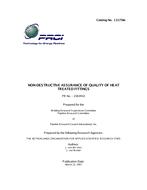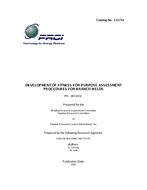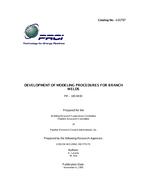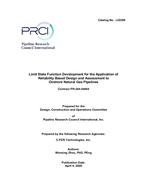Provide PDF Format
PRCI PR-003-073505
- Augmenting MFL Tools With Sensors That Assess Coating Condition
- Report / Survey by Pipeline Research Council International, 03/15/2009
- Publisher: PRCI
$6.00$12.00
L52298e
Battelle Memorial Institute
Need: External coatings are routinely used to protect transmission pipelines from corrosion; however, coatings may degrade or disbond over time enabling corrosion to occur. Transmission pipeline operators often use magnetic flux leakage (MFL) in-line inspection tools to detect metal loss corrosion defects. Rather than finding the cause of a problem, failure of the coating within a corrosive environment, MFL corrosion surveys only find the result of the problem, corrosion defects that may permanently alter the pressure carrying capacity of the pipeline. Stress corrosion cracking (SCC) can be detected using in-line inspection (ILI) technology, but the availability of tools is limited and the cost of inspection is high compared to MFL inspection. SCC almost always occurs at coating faults; direct coating assessment could indicate future problems that could degrade the serviceability of the pipeline.
Result: In this project, a new sensor was developed to assess external coating that could work with currently available ILI tools for minimal additional cost to perform the inspection. The sensors, electromagnetic acoustic transducers (EMATs), generate ultrasonic waves that are guided by the pipe material around the circumference of the pipe. The coating material and adherence can influence the propagation of the ultrasonic waves; changes in ultrasonic signal features were attributed to coating faults. This development used modeling and experiments to establish a more optimal configuration for coating assessment. A multiple feature approach was used. A commonly used feature, signal amplitude, provided good sensitivity to coating condition but was influenced by inspection variables. One unique feature identified in this development is arrival time of the ultrasonic wave. For the wave type and frequency selected, the wave velocity was different for bare and coated pipe. Therefore, disbonded or missing coating can be detected by monitoring arrival time of the ultrasonic wave, a feature that is amplitude independent. Another feature for assessing coating, absorption of selective frequencies, was also demonstrated. Coating assessment capability was experimentally demonstrated using a prototype EMAT ILI tool. All three detection features were shown to perform well in an ILI environment as demonstrated at Battelle's Pipeline Simulation Facility and BJ Inspection Services pull rigs. Improvement to the prototype occurred between each test; the most significant improvement was the design and construction of a novel set of thick-trace transmitting and receiving Printed Circuit Board (PCB) EMAT coils. Implementation variables such as moisture and soil loading were shown to have a minimal influence on results.
Benefit: Pipeline companies use inline inspection (ILI) tools to detect these anomalies and repair methods to mitigate the result of a failed coating. This project developed inspection sensors that could prevent these anomalies from occurring in the first place by monitoring the integrity of the external protective coating of the pipeline. This coating assessment could be performed during typical ILI that will help pipeline owners assess the general health of the coating protecting their pipeline system. The result of this approach was the fundamental improvement over existing methods. A goal of the design was to keep these sensors simple so that an implementation would not add substantial cost or complexity to a typical magnetic flux leakage (MFL) or caliper survey. Another feature for assessing coating, absorption of selective frequencies, was also demonstrated. Along with the benefit of knowing coating condition, this technology could help justify longer reinspection intervals for corrosion surveys. For lines with a few manageable corrosion anomalies as demonstrated by a MFL survey, verifying that the protective coating is intact would help justify that the threat is properly addressed. An additional benefit would be improved assessment of the stress corrosion cracking (SCC) threat. One method to assess whether SCC is present on a pipeline is to conduct bell hole excavations. The excavations are sometimes focused by soil modeling to establish that susceptible environment is present. The coating assessment results available from this new technology could be used to focus digs at locations with coating faults. Fewer excavations could be performed to establish the viability of the threat.
Battelle Memorial Institute
Need: External coatings are routinely used to protect transmission pipelines from corrosion; however, coatings may degrade or disbond over time enabling corrosion to occur. Transmission pipeline operators often use magnetic flux leakage (MFL) in-line inspection tools to detect metal loss corrosion defects. Rather than finding the cause of a problem, failure of the coating within a corrosive environment, MFL corrosion surveys only find the result of the problem, corrosion defects that may permanently alter the pressure carrying capacity of the pipeline. Stress corrosion cracking (SCC) can be detected using in-line inspection (ILI) technology, but the availability of tools is limited and the cost of inspection is high compared to MFL inspection. SCC almost always occurs at coating faults; direct coating assessment could indicate future problems that could degrade the serviceability of the pipeline.
Result: In this project, a new sensor was developed to assess external coating that could work with currently available ILI tools for minimal additional cost to perform the inspection. The sensors, electromagnetic acoustic transducers (EMATs), generate ultrasonic waves that are guided by the pipe material around the circumference of the pipe. The coating material and adherence can influence the propagation of the ultrasonic waves; changes in ultrasonic signal features were attributed to coating faults. This development used modeling and experiments to establish a more optimal configuration for coating assessment. A multiple feature approach was used. A commonly used feature, signal amplitude, provided good sensitivity to coating condition but was influenced by inspection variables. One unique feature identified in this development is arrival time of the ultrasonic wave. For the wave type and frequency selected, the wave velocity was different for bare and coated pipe. Therefore, disbonded or missing coating can be detected by monitoring arrival time of the ultrasonic wave, a feature that is amplitude independent. Another feature for assessing coating, absorption of selective frequencies, was also demonstrated. Coating assessment capability was experimentally demonstrated using a prototype EMAT ILI tool. All three detection features were shown to perform well in an ILI environment as demonstrated at Battelle's Pipeline Simulation Facility and BJ Inspection Services pull rigs. Improvement to the prototype occurred between each test; the most significant improvement was the design and construction of a novel set of thick-trace transmitting and receiving Printed Circuit Board (PCB) EMAT coils. Implementation variables such as moisture and soil loading were shown to have a minimal influence on results.
Benefit: Pipeline companies use inline inspection (ILI) tools to detect these anomalies and repair methods to mitigate the result of a failed coating. This project developed inspection sensors that could prevent these anomalies from occurring in the first place by monitoring the integrity of the external protective coating of the pipeline. This coating assessment could be performed during typical ILI that will help pipeline owners assess the general health of the coating protecting their pipeline system. The result of this approach was the fundamental improvement over existing methods. A goal of the design was to keep these sensors simple so that an implementation would not add substantial cost or complexity to a typical magnetic flux leakage (MFL) or caliper survey. Another feature for assessing coating, absorption of selective frequencies, was also demonstrated. Along with the benefit of knowing coating condition, this technology could help justify longer reinspection intervals for corrosion surveys. For lines with a few manageable corrosion anomalies as demonstrated by a MFL survey, verifying that the protective coating is intact would help justify that the threat is properly addressed. An additional benefit would be improved assessment of the stress corrosion cracking (SCC) threat. One method to assess whether SCC is present on a pipeline is to conduct bell hole excavations. The excavations are sometimes focused by soil modeling to establish that susceptible environment is present. The coating assessment results available from this new technology could be used to focus digs at locations with coating faults. Fewer excavations could be performed to establish the viability of the threat.
Related Products
PRCI PR-185-9332
Development of Fitness-for-Purpose Assessment Procedures for Branch Welds..
$25.00 $49.00
PRCI PR-244-04404
Limit State Function Development for the Application of Reliability Based Design and Assessment to ..
$98.00 $195.00





